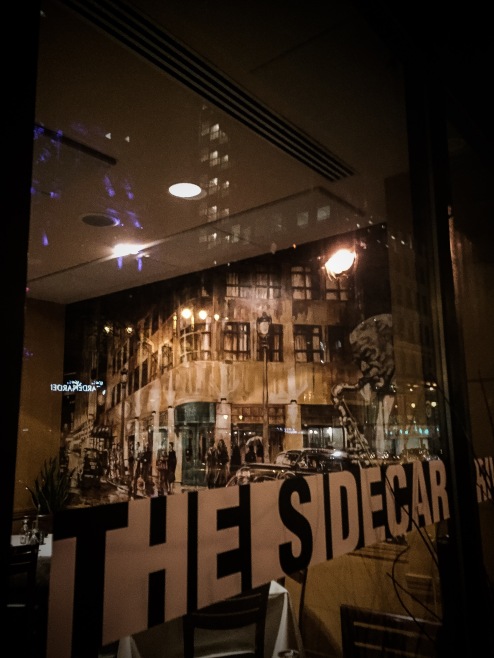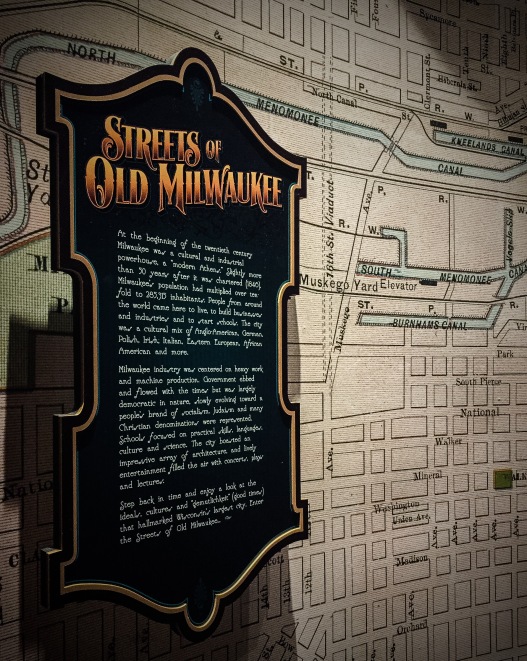Even at “Happy” Hour, ½ of the lounge’s customers stare into a screen, propped up on the table or in the palm of the hand. Some are subtle, in their business suits, sneaking a peek between business conversations, while others rest their elbows on the table, with two screens “live” between girlfriends out for a ½ price martini.
It’s not an unusual scene these days, at least in a Midwestern city like Milwaukee. If these technophiles do put their devices to sleep, and make eye contact, the phones, tablets and laptops are still on the bar, ready to be attended to, should someone reach out through cyber space. When the device stays dark for too long, they check to make sure it’s still working, or enter a password to download messages, or scan FaceBook.
I have to include myself in this group, as I check one last email for the day, while I wait for the busy waiter to find me. I’d searched the edges of the room, looking for an outlet to plug my laptop into, choosing an unlikely spot in a corner at one end of the lounge. My comfortable leather chair seems well suited to easy after-work conversation, unwinding with an Old Fashioned. That’s the $5 cocktail special of the day, during a generous Happy Hour that lasts from 3 – 7 pm.
I’m at the Hotel Metro, downtown Milwaukee. The corner entrance to the historic, Art Deco inspired hotel sets the tone for the entire building. The hotel’s small restaurant includes an enclosed, private dining area called “The Sidecar”. There is a mural painted along the back wall, to remind customers of the city’s lively past. I’m settled in the welcoming lounge adjacent to the private dining, with its intimate tables and a bar of top-shelf liquor bottles, colorfully lit from beneath.

There are very few empty seats. Cozy dinner tables are scattered about. A row of bar stools, and small round high-top bar tables along the booth-lined windows are full, but the people seated at them aren’t really here. . . many seem far away, in their own little worlds of FaceBook, Instagram, Twitter, Skype, and Pinterest. They might be “with” a long-distance boyfriend, in his apartment across the country, perhaps catching up with family on the other side of the world, or trying to connect with a stranger across the bar, by way of Tinder.
“Tinder is how people meet,” declares the company’s website, “It’s like real life, but better.”
As I’ve moved from city to city, and traveled extensively on business, I’ve done my fair share of online dating, company organized webinars via Skype, and 3 – 4 simultaneous, fast paced texting conversations, thanks to the latest technologies. This lifestyle, and these high tech means of communication are efficient, and they are here to stay. However, I’m not entirely convinced it’s better.
On the plane to Milwaukee, through Chicago’s busy O’Hare airport, I kept dozing off while reading my latest nonfiction book: Your Brain on Nature: The Science of Nature’s Influence on Your Health, Happiness and Vitality. My tired eyes are no fault of the book, as it was just shy of 6 am when the parking lot shuttle dropped me at the airport terminal. The shuttle was full of business travelers like me, with bags they can carry on, each with their face directed downward, towards a phone in their lap. A top exec at my company calls this saying “prayer” over the meeting, and it is strictly forbidden during company conferences. The majority of the travelers feel there is no need to tip the shuttle driver; all he did was drive the vehicle, after all. Noticing the lack of engagement on the part of my fellow travelers, I try to make up for it as best I can.
Okay, so maybe the research-heavy format of the book did contribute just a little bit to my heavy eyelids. It’s a book full of psychological studies, fMRI scans, control groups and citations. It’s a book for an academic, and it reminds me of my graduate school days, studying Philosophy of Psychology and Neuroscience. Only having read the first few chapters, the book’s opening message is bouncing around in my head as I try to keep up with the airport pace.
In addition to listing the benefits of a lifestyle that includes being exposed to nature, the initial claims of the book are about how damaging residing in metro areas can be to mental health. But I’m just visiting for a few days this week, so I won’t suffer any ill effects . . . right? Except I live in Columbus, grew up just outside of Chicago, and called Milwaukee my home for 4 undergraduate years. The book goes on to discuss the “disconnection” that comes from living in a high-tech, screen dominated culture. It’s about the breakdown of personal, real connection between residents of (or visitors to) the “Big City”.
Is Milwaukee really the “Big City”? Is it a growing and expanding metro area? Or is it still a bit of a cow town? I can’t make up my mind about where Milwaukee lands on the spectrum. Or Columbus, Pittsburgh, Indianapolis or Louisville, for that matter! There is art and entrepreneurship, suburban expansion and downtown revitalization, Metro Parks and architecture walks, rush hour traffic and alternate transportation. You’ll find bike share, cars you can borrow to get from one side of downtown to the other, busses, trains, taxies and Uber. It’s an exhilarating pace, if you lean into it and simply let it be. It’s an exciting pace, if you want it to be. It’s also an exhausting pace, if you allow it to be.
Everything is “popping up” in the city, with an air of impermanence, and a drive to be forever new and fresh. Unexpected spaces are transformed into everything from Pop-Up restaurants that thrive on collaboration between those in the food and drink industry, to Pop-up Art Galleries that can bring a contemporary edge to historic spaces. At the Pfister, one of Milwaukee’s most upscale and historic hotels, a portrait art display has taken over the front window, playing with the effects of light. The exhibit draws a less traditional crowd, into its grand elegance and historic tradition.
Across town, and having undergone extensive renovations in the past 20 years, the Milwaukee Public Museum has recently made improvements to its popular “Streets of Old Milwaukee” exhibit, which maps out how the city got its start. A sign declaring Milwaukee to be a cultural and industrial powerhouse is the first thing you see, at the entrance to the exhibit. Cultural diversity flourished, and the museum’s mockup of the city streets invites visitors to travel back in time, and explore that diversity. There was constant motion on the city streets, even then. Transportation was changing, and factories were increasing their production capacity. The city was evolving, making room for something new. Perhaps this change made the city better; the city most certainly wasn’t going to slow down for anyone.

But not everyone in Milwaukee cares to keep up with the fast pace, the latest technology or the so-called “advanced” methods of communication. There’s a space where the employees place a small, hand written sign that says “Back in 5 min”, when necessary. There’s no computer catalog of the inventory on site, although an employee who has been there for 25 years seems to have a pretty good idea of where everything is. Books are stacked on shelves, in boxes, and covering every surface in the place. Someone might want to get to work on organizing, but the guy at the counter is busy with his nose in a hardback volume. His “Pause” button might be a simple paper bookmark, but he’ll use it if a customer needs his assistance.
If we could hold on to that genuine customer service, rely on the knowledge of experts (and not “Google” everything), and recommend classics to the 2nd grader that just walked into the bookstore. . . would this city life really be so bad, or cause any real danger? This used bookstore is positioned at the Milwaukee airport, so it’s one of the first things to greet visitors when they arrive. It’s a throwback to a paper age!
Can small efforts like keeping this old bookstore up and running combat the negative effects of city life? It might still be better for my health to get outside into the warm spring sunshine. Perhaps I simply have more cities I’ll have to explore, before I can decide what I think of the city life. Perhaps I should finish the book on my next flight. Perhaps I ought to go on a short nature hike once back in Columbus, taking advantage of the greener side of “city life”. Perhaps that would slow me down, for better or worse.
“I’m in a hurry to get things done!
Oh, I rush and rush until life’s no fun.
All I really gotta do is live and die.
But I’m in a hurry and don’t know why!”
~ Alabama’s I’m in a Hurry (and Don’t Know Why)
Join me on my next adventure!
~ Kat
Related Links:
Hotel Metro Milwaukee: http://www.hotelmetro.com/about-en.html
Tinder: https://www.gotinder.com/
Uber: https://www.uber.com/
Visit Milwaukee: http://www.visitmilwaukee.org/
Experience Columbus: http://www.experiencecolumbus.com/
Pfister Hotel: http://www.thepfisterhotel.com/
Alabama’s “I’m In a Hurry (and don’t know why)”: https://www.youtube.com/watch?v=vAZOCgR6pmM















Very thought provoking!
LikeLike